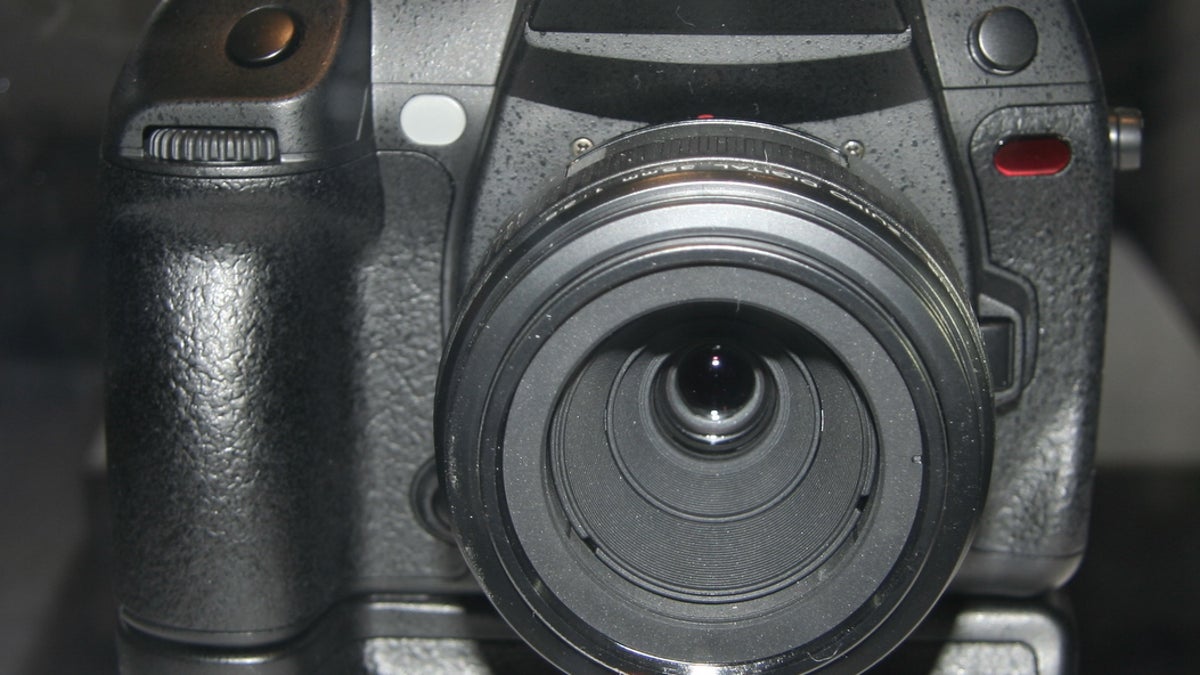Olympus could announce top-end SLR in October
An apparently leaked presentation sheds light on likely features of Olympus' upcoming high-end digital SLR, likely to be called the E-P1.

Olympus publicly showed prototypes of its new top-end digital SLR in March, but a leaked document indicates the real thing could be announced in October and on sale in November.
An anonymous person posted a 27-page presentation at the FourThirds Photo discussion site that appears to be from an Olympus marketing presentation in June in Europe on the new camera, called the E-P1. Olympus didn't comment on the presentation Thursday, but the company did request another site, 4-3system.com, remove the file.
The presentation includes numerous details about the camera--including its 10-megapixel sensor, improved viewfinder, sealing against dust and wet weather, wireless flash controller and better autofocus. But another interesting element is what Olympus positions as the competition: the Nikon D200 and Canon EOS 30D. That's interesting because Olympus is pitching the E-P1 as a professional-grade camera, whereas those Nikon and Canon models are considered a notch down in the "prosumer" category.
Olympus already has said on the record it's preparing to sell a successor this year to the E-1 launched in 2003, and it's begun offering teaser ads for it.
Going up against the Nikon D200 and Canon 30D, and supposed successors, the D300 and 40D, the E-P1 will have superior weatherproofing, technology for removing dust stuck on the image sensor, live preview of images on the LCD screen, a larger viewfinder, built-in image stabilization and faster autofocus, according to the presentation.
Missing from the presentation was any mention of price, but if Olympus hopes to take on the D200 and 30D directly, it should come in at less than $2,000. Olympus is hoping for indirect effects, though, according to the presentation: a "top-down" effect that will goose sales of lower-end E-410 and E-510 SLRs and of accessories.
Olympus SLRs, along with those from Panasonic and Leica, employ the Four Thirds lens mount system, so lenses and cameras from those companies are compatible. The image on such cameras has a four-to-three aspect ratio, squarer than the usual three-to-two on 35mm film SLRs and most other digital SLRs. The field of view of a Four Thirds lens is half that of a 35mm SLR lens with the same focal length, so a 50mm lens works much like a 100mm lens on a Four Thirds camera.
The presentation also describes four Four Thirds lenses, three of them professional-grade. The good ones are a 50-200mm (100-400mm equivalent) telephoto zoom with an F/2.8-3.5 aperture due in November; a 12-60mm zoom (24-120mm equivalent) zoom with an F/2.8-4.0 aperture due in October; and a 14-35mm (28-70mm) with a fast F/2.0 aperture due in the spring of 2008. The fourth lens, a 70-300mm model of more ordinary quality, has an aperture of F/4.0-5.6, has specs that match an official June announcement from Olympus. Also in the presentation is the EC-20 teleconverter to double telephoto focal length.
But back to the alleged E-P1 specs, which sound pretty good:
• Five frames per second shooting with a maximum shutter speed of 1/8000 sec.
• Eleven-point autofocus, and all points are cross-type, meaning they can detect either vertical or horizontal edges. Lower-end SLRs commonly have mostly linear points that aren't as sensitive. And autofocus works better in dim conditions than before.
• In-camera image sensor stabilization to counteract camera shake. That's been Olympus' approach already, but the new version is more powerful, permitting compensation that can allow use of shutter speeds up to five steps slower than otherwise would be possible. That could be significant, since Canon and Nikon build image stabilization into the lens, claiming that it works better when tuned to the specific lens, especially with telephoto lenses.
• Wireless control of flash units--and two new flash units, the FL-36R and FL-50R.
• An LCD that can swivel to different angles to aid with live view composition. Live view modes haven't generally wowed reviewers, but one handy feature permitted by swiveling screens is a better ability to shoot when the camera is held overhead or low to the ground.
• A large viewfinder that covers 100 percent of the camera view and magnifies it by a factor of 1.15. Most lower-end SLRs only cover 95 percent or so of the view and often shrink it, which produces eyestrain and makes manual focusing more difficult.
• A dust-reduction system to clean the image sensor, a bane of digital SLRs but a problem Olympus competitors are beginning to address with sensor-shaking technology.
• A weather-sealed extra battery compartment that can aid in shooting vertically-oriented pictures.

